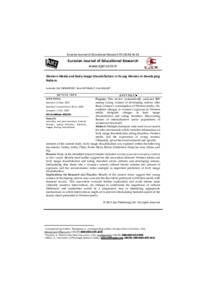Document
Western media and body image dissatisfaction in young women in developing nations.
Identifier
DOI: 10.14689/ejer.2020.90.3
Source
Eurasian Journal of Educational Research. v. 2020, 90, p. 45-66
Contributors
Poyrazli, Senel., Author
Miller, Erin., Author
Country
Turkey
Publisher
Ani Publishing.
Gregorian
2020-01-01
Language
English
English abstract
Purpose: This review systematically analyzed BID among young women of developing nations after these women’s consumption of Western media. We explored changes in women’s exposure to Western media alongside changes in body image dissatisfaction and eating disorders. Reoccurring themes of internalization across populations of women are discussed. Method: Multiple databases were used in our search for relevant research which included information on body image dissatisfaction, eating disorders, Western media, and the experiences of young women. Ultimately, given the extant research and specific interests of the current study, body image dissatisfaction was explored within the following ten nations: Turkey, India, China, South Africa, Belize, Zimbabwe, Malaysia, Iran, Oman, and Fiji. Results: Many of the identified research studies included secondary and post-secondary students as their sample. Results lend further support for the association between Western media and body image dissatisfaction and eating disorders across cultures and developing nations. Internalizing thin ideals into a woman’s current cultural beauty schema, her amount of exposure, and her socioeconomic status emerged as important predictors of body image dissatisfaction. Implications for Research and Practice: Results of the current study suggest that young women of developing nations may associate the thin ideals portrayed in Western media with financial success. This association warrants further exploration and could inform more culturally sensitive interventions. An attempt to understand the importance of cultural differences and similarities would be a progressive step in identifying appropriate mechanisms on which interventions might act to prevent internalizing harmful aspects of the beauty ideals presented in Western media.
ISSN
1302-597X
Resource URL
Category
Journal articles

